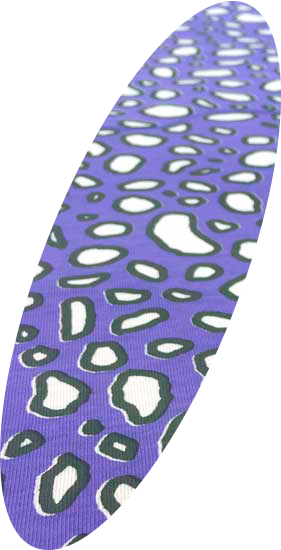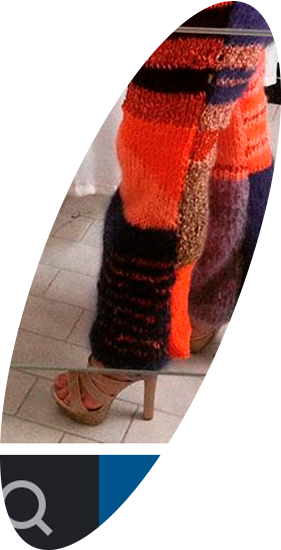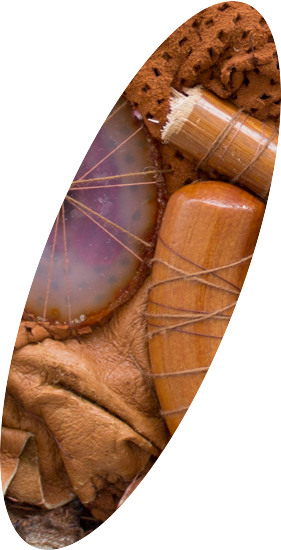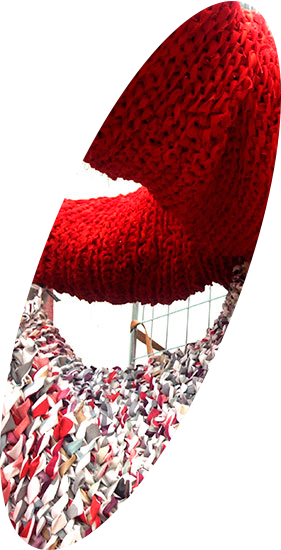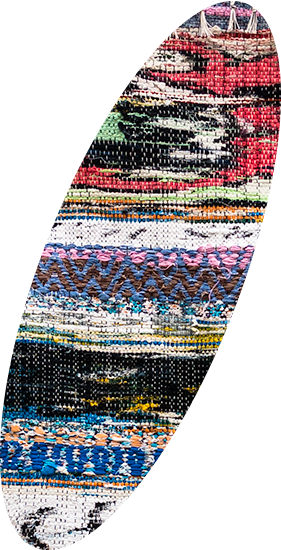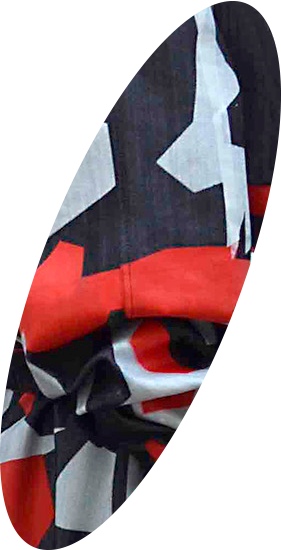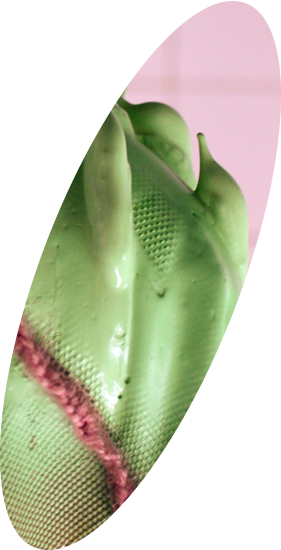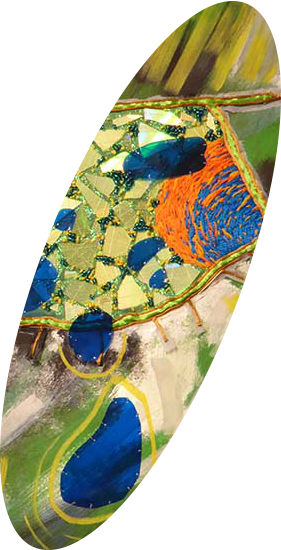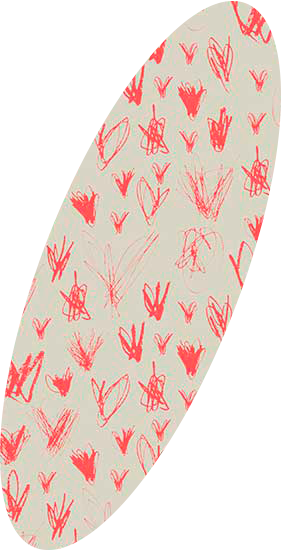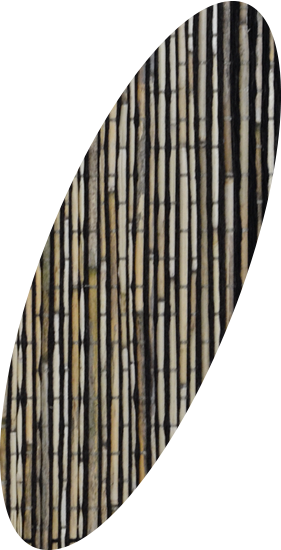For a number of years, the field of textiles has been in the midst of an incredibly exciting and dynamic development phase, where the potential of the materials and crafts are tested and cross-pollinate other fields of knowledge and are enabled to push their positions forward.
This takes place in parallel within many areas, such as crafts, design, art, research and theory-building, smart textiles, internet of things, material developments, consumer patterns, production processes and environmental impact. These different areas are not in opposition to each other, instead they create a focus on textiles where the sum is greater than the individual parts.
Many of these trends can be found in this year’s degree projects, even though the specialisation within Textiles since 2015 has been craft with an emphasis on the activities in our workshops and “doing” in relation to a material.
A degree project is about taking an idea and based upon this, being able to initiate, develop, plan and conduct a project. The ten departing students from this year’s Bachelor programme in Textiles show great range in their degree projects. One thing they all have in common is the “doing” in relation to a material.
Over the past three years, the bachelor’s students have worked to deepen their knowledge and questioning skills in both practical and theoretical work. They have developed their methodology, artistry and critical abilities step by step and are now able to use their degree projects to summarise and present their knowledge at this year’s Degree Exhibition.
Agnes Varhelyi – the bold colours of poisonous frogs that signal “dangerous to eat” – Aposematism – was a starting point, as Agnes worked with patterns and garments for a gang of girls whose aim is to challenge patriarchy.
Cecilia Pfaff – challenges our understanding of knitting as a craft and how we see it through the digital lens.
Ellen Skafvenstedt – uses appliqué, an investigative act of doing as a technique for transforming and working with materials in her surroundings.
Evelina Kollberg – examines how she can use her craft to visualise the different choices humans face and how craft can influence us to make alternative, conscious and more sustainable decisions.
Josefin Gäfvert – wants to raise the awareness of structures that have restricted woven fabrics. Using her carpets, she investigates how the weave and the woman belong together – historically and in modern times.
Klara Thorselius – with her own direction and desires within streetwear, she transports the power of military garments through male streetwear and to the new wearers – women.
My Adborn – attempts to restrain feelings in the same way she attempts to restrain materials and craft. A textile investigation of the gap between the bodily experience of who you are and the striving of the consciousness to be who you want to be.
Sigridur Eggertsdottir – invites the observer to see into the chaos with an alternative, embroidered, hand-crafted fiction.
Sofia Wall – has worked with a pattern collection on the theme of love. This is illustrated with a circle of love. The circle divides the different phases of love into parts. Each part is represented by a pattern.
Vega Siltberg – designs and weaves a site-specific textile from locally grown materials such as reeds, wool and linen. One of the project’s main focuses is to examine and develop a modern approach to handicrafts.
We, who have had the pleasure of following and working with this year’s graduating students, welcome you all to come see their elaborate and exciting degree projects. We look forward to following them in the future. Good luck!
Ulrika Mårtensson
Senior Lecturer in Textiles
Det textila området befinner sig sedan ett antal år i en oerhört spännande och dynamisk utvecklingsfas, där materialens och hantverksteknikernas potential testas och korsbefruktas med andra kunskapsområden och tillåts skjuta fram sina positioner.
Detta sker parallellt inom många områden som exempelvis konsthantverk, design, konst, forskning och teoribildning, smart textiles, internet of things, materialutveckling, konsumtionsmönster, produktionsprocesser och miljöpåverkan. De olika områdena ställs inte som motsatser till varandra utan skapar istället ett fokus på textil där summan blir större en de enskilda delarna.
Många av dessa trender kan spåras i årets examensprojekt, även om huvudområdet på Textil sedan 2015 är konsthantverk med en tyngdpunkt på arbetet i våra verkstäder och görandet i förhållande till ett material.
Ett examensarbete handlar om att utifrån en idé kunna initiera, utveckla, planera och genomföra ett projekt. Årets 10 kandidatstudenter från Textil visar stor bredd med sina examensarbeten. Gemensamt för alla är görandet i förhållande till ett material.
Under de gångna tre åren har kandidatstudenterna arbetat med att fördjupa sina kunskaper och frågeställningar i såväl praktiska som teoretiska arbeten. Stegvis har de utvecklat sin metodik, konstnärlighet och kritiska förmåga för att sammanfatta och presentera sina kunskaper med examensprojekten i vårutställningen.
Agnes Varhelyi – giftiga grodors starka färgteckning, som signalerar ”farlig att förtära” – Aposematism – har varit utgångspunkten då Agnes arbetat med mönster och plagg för ett tjejgäng vars syfte är att utmana patriarkatet.
Cecilia Pfaff – ifrågasätter vår uppfattning om stickning som hantverk och hur vi ser på detta hantverk genom den digitala linsen.
Ellen Skafvenstedt – använder sig av applikationsbroderi, ett undersökande görande som teknik för att transformera och bearbeta material som finns i hennes omgivning.
Evelina Kollberg – undersöker om hon genom sitt hantverk kan synliggöra de olika val vi människor ställs inför och om hantverket kan förändra oss till att istället göra medvetna val i en mer hållbar riktning.
Josefin Gäfvert – vill medvetandegöra strukturer som hållit väven tillbaka. Genom sina mattor undersöker hon hur väven och kvinnan hör ihop, historiskt och idag.
Klara Thorselius – med en egen riktning och vilja inom streetwear förflyttar hon de militära plaggens makt, genom herrmodets streetwear till nya bärare: kvinnorna.
My Adborn – försöker tygla känslor på samma sätt som hon försöker tygla materialen och hantverket. En textil undersökning av glappet mellan den kroppsliga erfarenheten av den du är och medvetandets strävan efter den du vill vara.
Sigridur Eggertsdottir – vill bjuda in betraktaren att se in i Kaoset med en alternativ broderad hantverkad fiktion.
Sofia Wall – har arbetat med en mönsterkollektion med temat kärlek. Detta illustreras med en kärlekscirkel. I cirkeln delas kärlekens olika faser upp i delar. Varje del representeras av ett mönster.
Vega Siltberg – formger och väver en platsspecifik textil av närodlade material som vass, ull och lin. En av tyngdpunkterna i projektet är att undersöka och utveckla ett modernt förhållningssätt till hemslöjd.
Vi som har haft förmånen att få följa och arbeta med årets examensstudenter välkomnar alla att ta del av deras genomarbetade och spännande examensarbeten. Vi ser fram emot att få följa dem i framtiden! Lycka till!
Ulrika Mårtensson
Lektor i textil

 Visit: LM Ericssons väg 14, Stockholm
Visit: LM Ericssons väg 14, Stockholm